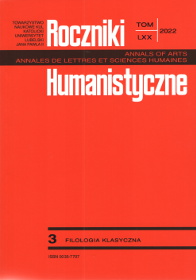Teoria artefaktu. W stronę krytyki ikoniczności dawnych Greków
Artifact Theory: Towards a Critique of the Iconicity of the Ancient Greeks
Author(s): Sebastian BorowiczSubject(s): History, Fine Arts / Performing Arts, Visual Arts, Ancient World, History of Art
Published by: Towarzystwo Naukowe KUL & Katolicki Uniwersytet Lubelski Jana Pawła II
Keywords: artifact; image; iconicity; visuality; chōros culture; diakrisis culture; critical approach
Summary/Abstract: The artifact theory is part of the author’s project of iconicity criticism presented in his book Reliefy rozmazane. Rzeczy i obrazy w kulturze dawnej Grecji [Smeared Reliefs: Things and Images in Ancient Greek Culture] (2020). It aims to remodel foxed thinking about products of Greek culture from the archaic and classical periods in the perspective from the category of the image entangled in philosophical discourse, and thus having an unclear and historically variable status. The category of artifact, proposed in place of the image encompasses all artistic products and social activities, practices, and the games associated with them, as well as their worldview motivations. The artifact is thus a kind of socially embedded dynamic iconic entity. The notation in partial italics is meant to distinguish this concept from the archaeological artifact, the thing in its purely material physical dimension. The artifact category also emphasises the processual character of the perception of things in ancient cultures, e.g. the becoming instead of the being. According to the theory presented, a vessel, a statue, or a painting has not as much a visual dimension as a performative and agentive one; it is a form of interference in the world. The dynamics of looking at things was, moreover, dependent on the environment, which is revealed, for example, in the different way in which Homer’s Telemachus looked at artifacts in the palace of Menelaus and in that of Nestor. This difference is presented by the author within the framework of two distinguished types of culture chōros (χῶρος) and diakrisis (διάκρισις). In the second part of the article, the status of iconicity in archaic culture is redefined using a critical approach. It is a cognitive strategy aimed at revealing and characterizing the games and social practices behind the forms of artistic disposition inherent in Greek culture. Iconicity in the critical perspective is not so much the result, or outcome of something serving aesthetic purposes, but rather one of the activities that make up what a given statue or painting is as a state of affairs (Sachverhalt).
Journal: Roczniki Humanistyczne
- Issue Year: 70/2022
- Issue No: 3
- Page Range: 7-26
- Page Count: 20
- Language: Polish

